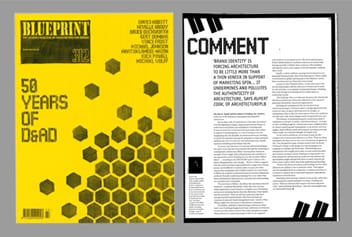Blueprint Magazine article on ‘Brand Identity’ by Rupert Cook
Date posted: February 28, 2012
In the March edition of Blueprint Magazine, director Rupert Cook comments on the impact of ‘Brand Identity’ on contemporary architecture.
Architecture and Brand Identity
The idea of “brand” and the notion of “branding” are, I believe, irrelevant to the making of meaningful and purposeful architecture. All too often talk of “brand identity” has taken precedence over the importance of place, planning and relevant design. It undermines and pollutes the authenticity of architecture. It forces architecture to become little more than a thin veneer in support of marketing spin, or a way of trying to turn the unappealing into the desirable. In architectural terms, branding is a proxy for authentic response by architects to client and brief. Architecture, if it is to have any real and lasting value, should represent something much deeper than this.
In recent years, however, it is not just individual buildings, but entire cities that have been branded through the marketing of contemporary architecture. Bilbao “has long been cited as an example of how a large-scale cultural project can contribute to the regeneration and re-branding of a city the so-called “Bilbao Effect…’according to the 2004 DCMS report Culture ate the Heart of Regeneration, even though “…Recent evidence suggests that the initial economic surge produced by a large-scale cultural project can be difficult to sustain unless it is part of a wider regeneration programme and is firmly rooted in the community”. In Bilbao the emphatic architectural gesture has been shaped and produced through a marketing campaign for a city, rather than from a fundamental representation, and profound understanding, of a real place and a real people.
The antithesis to Bilbao – the Bilbao effect, that is, that has been so heavily marketed – is perhaps Manchester where the roots of recent urban regeneration can be found in a complex array of buildings and projects including Factory Records, Hacienda, Urban Splash and the University. These are all local endeavours that have emerged and developed naturally; they have not been the creations of some city brand management team -much as Tony Wilson might have laid claim to Manchester’s renaissance.
Post Bilbao, attempts to brand manage architecture often lead to new buildings designed as if local conditions are irrelevant or even as if they need to borrow from other disciplines to make them conform to a marketing image of who we are supposed to be and how we are meant to live. For all its sophistication, Foster’s Bexley Business Academy seems less of a school that belongs naturally to Bexley itself than a corporate office building airfreighted in from some remote, if heavily branded, corporate office world.
Equally, a whole aesthetic typology has developed out of a particular funding stream, that of the homogenous white-walled, wood-floored art gallery and museum of the 1990’s Lottery. Here is architecture as a National Lottery brand.
Caruso St John’s Walsall Gallery, on the other hand, with its rich relationship with the collection it houses and its sense of craft and place, is an example of unbranded design, a building that truly belongs to its setting and city rather than to a marketing concept.
The challenge, then, is to discover the gritty, visceral and the real in architecture, those true reflections of the values of particular institutions, places and organisations.
Buildings are containers for life, not for short-lived marketing strategies. Architects aspire to design spaces as living rooms for cities, as spaces allowing room for thought, as celebrations of day-to-day life, and as spaces where new traditions can take seed. And, where change can be incorporated over time.
The reliance on branding frequently comes from a lack of confidence on the part of clients –and even architects – in terms of what a building might be. Architecture is not a simple product for instant marketing and consumption; it can answer, and even suggest, many different needs and purposes including some that clients might not even have thought of to begin with.
In our work as architects, we try hard to seek out the complex mix of values and traditions of a client. These are often entwined with their town or city, even if sometimes forgotten or lost. Over the past five years, we have worked with the Royal Veterinary College on the design of several buildings at its campuses in Camden and Potters Bar. The buildings have emerged not from a rigidly given idea, or some marketing ideal – and certainly not from a Royal Veterinary College brand – but from exhaustive, and fascinating, studies of what distinct and special places might emerge from down-to-earth research and from a sense of place rather than from marketing and branding.
Think of the distinctive places and buildings you love: their identities are unlikely to be an artificial veneer. Their appeal can’t be simplified down to a strap-line, or mission statement: it is rooted in complex sets of emotional responses, expectations, experiences and memories. Branding is about putting ‘lipstick on the gorilla’ rather than representing the essence and spirit of a brief, a building and a place. These are elements that require a lot more long-term work – from architects and clients – than the rushed application of a fashionable brand.

